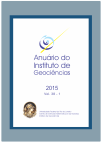Study of Primary Productivity of the Mata Atlântica Biome via Remote Sensing
DOI:
https://doi.org/10.11137/2015_2_05_14Keywords:
Sequester of Carbon, MOD17A2, ClimateAbstract
The remote sensing techniques have been widely used to estimate the primary productivity of large regions on the planet, and have proved a very useful tools and satisfactory results. Therefore, the present work aims to estimate and identify the spatial and temporal (seasonal, annual and inter-annual) patterns of the primary productivity on Mata Atlântica biome by remote sensing. Therefore, data from product MOD17A2 of MODIS sensor and meteorological data of air temperature and precipitation from the meteorological station of the National Institute of Meteorology located in the study areawere used. The orbital data have a spatial resolution of 1 km and a temporal resolution of 8 days. The study period covers the years 2002-2011. The net primary productivity showed a minimum value during the winter (19,6 % of the total study period) and a maximum value in the transition between spring and summer (30,1 % of the total study period). In relation to carbon sequestration in the studied region was observed that fixation offset the annual emissions. It was also concluded that during the period studied the carbon balance was slightly negative. However, was a trend of increasing carbon sequestration in the period 2003-2011.Downloads
Download data is not yet available.
Downloads
Published
2016-05-10
How to Cite
Paiva, C. M. and Fernandes, F. R. (2016) “Study of Primary Productivity of the Mata Atlântica Biome via Remote Sensing”, Anuário do Instituto de Geociências. Rio de Janeiro, BR, 38(2), pp. 05–14. doi: 10.11137/2015_2_05_14.
Issue
Section
não definida
License
This journal is licensed under a Creative Commons — Attribution 4.0 International — CC BY 4.0, which permits use, distribution and reproduction in any medium, provided the original work is properly cited.















